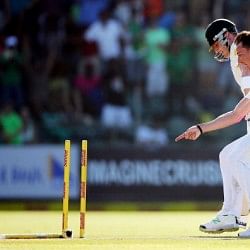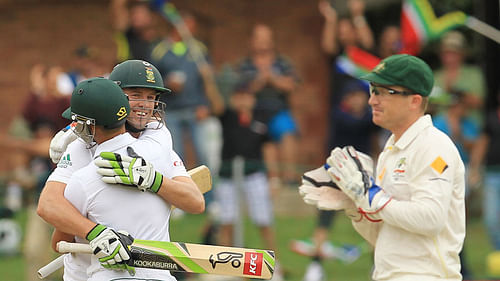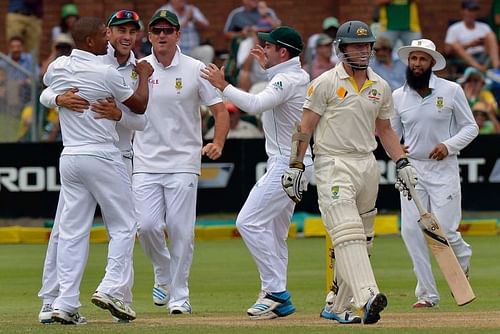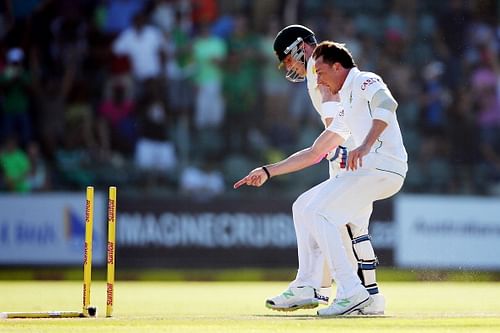
South Africa vs Australia 2014: Key factors in South Africa's win over Australia in second Test
This is the sort of cricket you expect from a No.1 ranked Test team. South Africa were completely out-played in the first Test, but came back strongly to win the second Test despite the rain-threat. AB de Villers scored a splendid century in the first innings which helped South Africa post a formidable 423. And Hashim Amla’s 21st century helped South Africa recover from 42/2 to set a target of 448 for Australia to win the match.
Australia had a solid opening partnership of 126 runs between Chris Rogers and David Warner. But after their dismissal, South Africa had no problems in running through Australia’s middle order.
So, let us look at some of the key performers of South Africa.
Dean Elgar’s 83 laid foundation for South Africa

Elgar’s innings laid solid foundation
Elgar doesn’t have much international experience as he has played only 7 Test matches, accumulating 215 runs at an average of 30.71. But when he was selected for this match, he had a significant task on hand. He had to face the likes of Mitchell Johnson and Ryan Harris who had troubled the world’s best batsmen on display.
Graeme Smith and him opened the innings for South Africa. However he felt nervous when he lost Smith and Amla in quick succession. The conditions were overcast, and the ball was moving both ways. Elgar’s task was to survive rather than going for shots.
The way he handled the situation was really remarkable. He was not pre-meditated. He was able to adjust his game according to the situation. When the Aussie pacers were moving the ball, he was watchful and didn’t play any ramp shots. He just concentrated on combating the swing which was a good idea. Because after the initial period, the wicket became better for batting and the Aussie pacers were not deriving any movement off the surface after the first session of day one. That’s the period when Elgar started dominating the Aussie pace attack.
His innings of 83 laid solid foundation for AB de Villers to build an innings. Had he been dismissed, South Africa wouldn’t have crossed the 400-run mark. It wouldn’t have also allowed AB de Villers to play without any pressure. Therefore Elgar played an important innings.
AB de Villers century out-played Australia

AB de Villers scored a brilliant hundred
When AB de Villers walked in at 123/3, he had Elgar playing well at the other end. After the wicket of Elgar, de Villers took the responsibility on his shoulders to play a long innings. The surface was slow, and Australia’s spinners were on a role at that moment. The spinners took three out of the five wickets that fell on day one. So AB de Villers’ task was to stay at the wicket and not to try anything fancy.
He did exactly what was required at that stage. He scored a brilliant half-century on the first day, and subsequently started attacking Australia’s spinners as well. Lyon was not getting any purchase from the wicket on the second day, and de Villers took full advantage of that.
His century was critical for South Africa as none of the lower order batsmen bothered to stay at the crease and bat sensibly. He stayed till the 124th over which meant the Proteas were in the driver’s seat.
Had he been dismissed quickly, Proteas wouldn’t have had a chance to win this Test match.
South Africa’s pacers role on day two

South Africa pacers ran through Australia’s top order on Day two
After South Africa’s innings was wrapped up for 423, their pacers were on a role as they claimed four wickets towards the end of the day’s play. South Africa’s pacers were brilliant and extracted life out of a dead pitch, and Australia’s batsmen had no answer for them. Morkel was the best bowler on day two as he was constantly deriving movement off the pitch. Only talented and experienced pacers can do this.
The good thing about Morkel was he was landing the ball in the full-length area. It was really difficult for batsmen to judge the movement when it is pitched full. Chris Rogers was not able to judge an incoming delivery off Philander, and thus was lbw for a mere score. Had they landed the ball on good length area, it would have made things easier for Australia.
Dale Steyn’s astounding spell to wreck Australia’s middle order

Dale Steyn ripped apart Australia with a devastating spell on Day 4
Steyn claimed only one wicket in the first innings. But he played an important role in the second innings as he ran through Australia’s middle order quickly to set up South Africa’s win. After Australia had a good opening partnership, it looked as if the Test would end in a draw as poor weather forecast could have come into play.
Australia’s middle order was also offering resistance to the Proteas bowling attack. But after the introduction of Steyn in his third spell, he removed Clarke, Smith and Haddin in the space of four overs which brightened the chance of South Africa. He was aggressive, attacking the batsmen and also had the fielders in catching positions. But what was good to see was he was bowling wicket-to-wicket which made things tougher for Australia to accelerate.
Had Steyn failed, the Test would have ended in a draw or might have produced the result on day five.